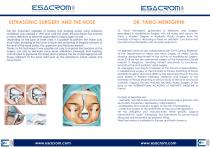
Catalog excerpts

ESACROM RESEARCH AND DEVELOPMENT DEPARTMENT PRESENTS "ULTRASONIC RHINOPLASTY" By Dr. Fabio Meneghini One hundred years after its birth, open rhinoplasty is renewed again and becomes ultrasonic. Any bone structure of the nose, superficial or deep, it can be shaped, sectioned or moved under direct visual control e without using the hammer and chisels anymore. DISCOVER OUR ULTRASONIC WORLD! On our social profiles you will find continuous updates on #Esacrom training, take part in our exclusive courses to find out more about our procedures! For other info and courses: Esacrom srl VIA ZAMBRINI,6/A-40026 IMOLA(BO) TEL. +390542643527 FAX +390542482007 esacrom@esacrom.com
Open the catalog to page 1
ULTRASONIC SURGERY AND THE NOSE The first instrument capable of incising and shaping bones using ultrasonic oscillations was created in 1997 and, over the years, this procedure has evolved in many directions to become applicable to nasal surgery as well. Depending on the type of insert used, it is possible to perform thin linear cuts, small holes, modeling of the bone surface and smoothing of irregular surfaces at the level of the nasal bones, the upper jaw and the bone septum. Thanks to this technique it was possible not only to improve the precision of the surgery, but also to eliminate...
Open the catalog to page 2
INNOVATION: what is it about? To perform an ultrasonic rhinoplasty it is necessary to modify the open technique (Open Rhinoplasty) by means of a large subperiosteal skeletonization of the nasal pyramid, in order to use all the steps of the operation under direct vision. In this sense, it can be said that with the advent of ultrasonic rhinoplasty, the direct control of the operator is total and there are no longer uncontrolled maneuvers entrusted to chance. Bone gibbotomy is performed respecting the underlying cartilages by accurately removing even the smallest deformities. The lowering can...
Open the catalog to page 3
CLINICAL CASES TARGETS Reduce intra and postoperative bleeding thanks to reduced trauma to the subcutaneous blood vessels and internal nasal mucosa (which are extremely vascularized). The procedure is in fact performed directly on the bone structures and this avoids damage to the tissues located above or below them; Reduce hematomas on the skin and postoperative swelling, again thanks to reduced tissue trauma; Model the bones of the nose without having to resort to the use of rasps, chisels and hammers, instruments that are replaced by a slower, but more delicate and precise, action of the...
Open the catalog to page 4All ESACROM catalogs and technical brochures
-
Book-Tips
124 Pages
-
Surgysonic Wound
2 Pages
-
ESA INCISA
2 Pages
-
SINUS LIFT
4 Pages
-
PIEZOCLEAN
6 Pages
-
Surgysonic II
48 Pages
-
Surgysonic Moto
48 Pages
-
BMS Implant II
48 Pages












